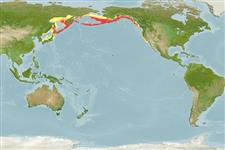Classification / Names
Common names from other countries
Main reference
Size / Weight / Age
Max length : 56.5 cm TL male/unsexed; (Ref. 56527); 35.0 cm SL (female); max. published weight: 2.0 kg (Ref. 56344); max. reported age: 15 years (Ref. 55701)
Length at first maturity
Lm 32.5 range ? - ? cm
Environment
Marine; demersal; depth range 0 - 720 m (Ref. 114138)
Climate / Range
Boreal, preferred ?; 64°N - 34°N, 130°E - 118°W
Distribution
North Pacific: between the middle Kuril Islands and Gulf of Alaska; including off the coast of Eastern Sakhalin, in the north of the Sea of Okhotsk, waters of Hokkaido, southern Kuril Is., and to the north up to Anadyr Bay. In the Sea of Japan, found once in northern Primorye and caught south of Moneron I. and in the open part of Peter the Great Bay (Ref. 114081). Southward range up to Redondo Beach, California (Ref.
Countries | FAO areas | Ecosystems | Occurrences | Introductions
Short description
IUCN Red List Status (Ref. 115185)
Threat to humans
Harmless
Human uses
Fisheries: commercial
Tools
Special reports
Download XML
Internet sources
Estimates of some properties based on models
Phylogenetic diversity index
PD50 = 0.7502 many relatives (e.g. carps) 0.5 - 2.0 few relatives (e.g. lungfishes)
Trophic Level
3.4 ±0.0 se; Based on diet studies.
Resilience
Low, minimum population doubling time 4.5 - 14 years (K=0.28; tm=3.6; tmax=15)
Vulnerability
Low to moderate vulnerability (30 of 100)
Price category
